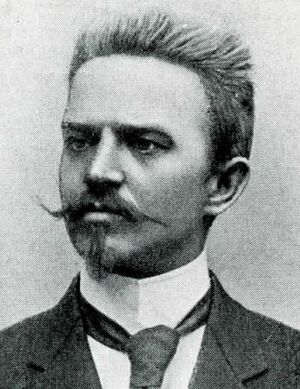A. A. Kannisto facts for kids
Quick facts for kids
A. A. Kannisto
|
|
|---|---|

Kannisto in 1908
|
|
| Member of the Parliament of Finland | |
| In office 22 May 1907 – 31 January 1911 |
|
| Constituency | Mikkeli Province |
| Personal details | |
| Born |
Anders Anshelm Käck
6 March 1876 Joroinen, Russian Empire |
| Died | 14 March 1930 (aged 54) Mikkeli, Finland |
| Political party | Social Democratic Party of Finland |
| Occupation | Carpenter |
Anders Anshelm Kannisto (1876–1930) was an important Finnish figure. He was a trade unionist (someone who helps workers), a politician, and a member of the Parliament of Finland. The Parliament is like the main law-making group for Finland. He belonged to the Social Democratic Party. He represented the Mikkeli area in Parliament from May 1907 to January 1911.
During the Finnish Civil War in 1918, Kannisto was part of a group called the Red Guard. He was taken captive by the White Guard when the war began. After the war, he faced difficulties and was held for a period. He was released in 1921.
Contents
Early Life of A. A. Kannisto
Kannisto was born on March 6, 1876, in Joroinen, Finland. His father, Gustaf Johan Käck, was a crofter (a small farmer). His mother was Gustava Vilhelmina Brask. Kannisto's father passed away when he was only five years old. His mother then raised him.
He went to folk school and later to a folk high school. These schools helped him learn important skills. Before 1908, he worked as a gardener and a carpenter in Joroinen and Sääminki. From 1908, he worked at the workers' association in Mikkeli. He started as a janitor and later became a manager. In 1902, he married Maria Silvennoinen, and they had two daughters. In May 1906, he changed his family name from Käck to Kannisto.
Joining the Labour Movement and Politics
Kannisto became involved in the labour movement when he was young. This movement worked to improve conditions for workers. At age 20, he joined the Social Democratic Party of Finland (SDP). He joined through the Kuopio Labor Association.
He played a key role in organizing the 1905 Finnish general strike in Savonlinna. A general strike is when many workers stop working to demand changes. In 1906, he helped distribute Vapaus, the SDP's newspaper in Mikkeli.
Kannisto's Time in Parliament
Kannisto was chosen to be a member of the Parliament of Finland in the 1907 election. He was re-elected several times. He won elections again in 1908, 1909, and 1910.
After the February Revolution in 1917, Kannisto was elected chairman. He led the food committee for Mikkeli Province in May 1917. He also ran in the 1917 parliamentary election.
Finnish Civil War and Its Aftermath
In November 1917, two different groups formed in Mikkeli. One was the White Guard, led by William Hjalmar Spåre and Hjalmar Nyberg. The other was the Red Guard, led by Kannisto and Alex Halonen. By January 1918, both groups had weapons.
Events in Mikkeli During the War
The Finnish Civil War began in late January 1918. In Mikkeli, both sides waited to see what would happen. On January 28, 1918, the White Guards destroyed bridges. This was to stop the Red Guard from moving around. The Red Guards set up their base at Mikkeli's People's House and the water tower. The White Guards were based at the lyceum (a type of school).
The White Guards surrounded the water tower. On January 29, 1918, they told the Red Guards to give up. The Red Guards surrendered without fighting. They gave up their weapons. Their leaders, Halonen and Kannisto, were taken captive. Other Red Guards were allowed to go home but were held later.
Kannisto's Release
After the civil war ended, Kannisto faced serious consequences. In August 1918, a court decided he would be held for a period. He was kept in a camp in Tammisaari. He was released from Tammisaari in June 1921.
Later Life and Community Work
After his release, Kannisto continued his work. He was the secretary for the SDP's branch in Mikkeli Province from 1921 to 1927. He then became its president until 1930. From 1926, he was a member of the municipal council in Mikkeli. This council helps run the city.
He also served on the boards of several local groups. These included the Mikkeli workers' co-operative, Osuusliike Savonseutu, and the Mikkeli workers' theatre.
Kannisto passed away on March 14, 1930, in Mikkeli. He had a heart attack. He was buried in Mikkeli's new cemetery on March 23, 1930.
See also
- List of MPs in Finland imprisoned for political reasons

